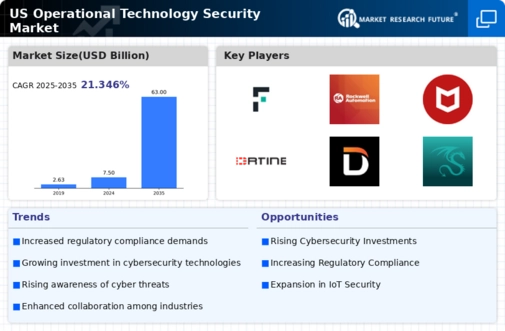The US Operational Technology Security Market has experienced significant growth owing to the increasing reliance on connected devices and the Internet of Things in industrial settings. As businesses enhance their operational technology ecosystems, they face a corresponding rise in cybersecurity threats that can jeopardize critical infrastructure. This market emphasizes the convergence of IT and OT security, necessitating integrated solutions to protect systems from cyber threats. Competitive insights reveal a dynamic landscape where companies focus on developing advanced security measures, gaining market share through innovation, collaboration, and strategic partnerships.
A growing emphasis on compliance, risk management, and customer-centric solutions also drives the competitive dynamics within this space.Forcepoint has carved a notable presence in the US Operational Technology Security Market by delivering solutions that focus on the protection of sensitive data and critical infrastructure. Its strengths lie in its behavioral analytics capabilities, which enable organizations to identify and respond to threats in real time. By leveraging artificial intelligence and machine learning technologies, Forcepoint enhances its offerings to adapt to evolving threats while providing a user-friendly experience.
The company's strategies include strong partnerships with key players in the cybersecurity ecosystem, ensuring their solutions integrate seamlessly within various operational frameworks. This approach strengthens Forcepoint's market position, elevating its brand as a leading provider in the operational technology security landscape and reflecting a comprehensive understanding of the unique challenges faced by industrial enterprises.ABB operates within the US Operational Technology Security Market by delivering a range of critical solutions aimed at enhancing the cybersecurity posture of industrial environments.
Known for its robust portfolio, ABB provides integrated products and services, including advanced control systems, network security applications, and cloud solutions tailored for OT environments. The company has established itself as a formidable player in the market through its commitment to innovation, regularly launching products designed to safeguard industrial systems against cyber threats effectively. ABB's strengths include extensive industry experience, a strong reputation for reliability, and a global reach that allows it to cater to diverse customer requirements. Moreover, its strategic mergers and acquisitions have enabled it to expand its technological capabilities and enhance its overall market presence.
By promoting collaboration among its various divisions, ABB exemplifies a comprehensive approach toward addressing the cybersecurity challenges inherent in operational technology, reinforced by a commitment to delivering high-quality service and solutions in the US region.























